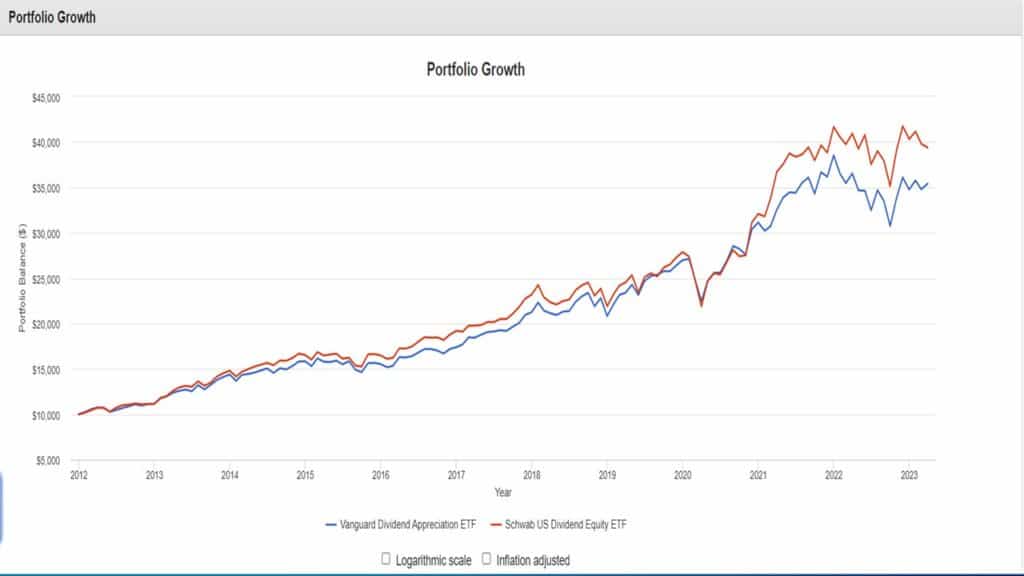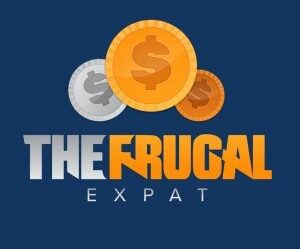You come across two great choices for the best high-dividend growth ETFs. You can choose either SCHD or VIG. Each ETF has its advantages and disadvantages when creating a portfolio for dividends. This article will break down SCHD vs VIG and help you, as investors, determine if either of these dividend ETFs can help your portfolio.
What is a Dividend ETF?
You can invest in either stocks or mutual funds, but in 1999 State Street came out with an ETF or exchange-traded fund. It is a type of mutual fund that is traded like a stock. Since then, many ETFs have popped onto the market.
For those interested in dividend investing and dividend stocks, the ETF has been a way to diversify your holdings making dividend investing much more straightforward. Vanguard ETFs have been known as some of the best on the market creating dividend ETFs like VYM and VIG.
Schwab has come on the market strong with their dividend ETF in SCHD.
SCHD: Schwab U.S. Dividend Equity ETF
SCHD is a high-growth dividend ETF that tracks the Dow Jones U.S. Dividend 100 index. It focuses on high-growth dividend stocks that fit in with particular criteria. It comprises 103 different stocks giving it a more concentrated in fewer stocks. It needs to be paying dividends for the last ten years consecutively, growing its dividend over the previous five years.
Each stock can have at most 4% of the allocation. That is a different factor when you compare SCHD vs VOO.
As a growth dividend ETF it looks at growing dividends over time. It has averaged over 12% dividend growth in the last five years. It has also had an average of 12% in the previous ten years of price appreciation. That stays on par with the S&P 500, so SCHD could do better than VOO.
With an expense ratio of 0.06%, the ETF is affordable to the retail investor. It will only cost $6 for every $10,000 invested.
If you are looking for yield over performance, the yield is also preferable having a 30-day SEC yield of 3.54%. That is more than many of the popular dividend stocks out there.
It also holds many popular dividend stocks in its top 10 holdings, like Coke Cola, Pepsi Co, and Home Depot. It allows investors to gain good exposure to many different sectors within the market.
SCHD Top Ten Holdings:
| Ticker Symbol | Company | Weight |
|---|---|---|
| ABBV | ABBVIE INC | 4.31 % |
| PEP | PEPSICO INC | 4.26 % |
| TXN | TEXAS INSTRUMENT INC | 4.24 % |
| UPS | UNITED PARCEL SERVICE INC CLASS B | 4.21 % |
| MRK | MERCK & CO INC | 4.20 % |
| CVX | CHEVRON CORP | 4.15 % |
| HD | HOME DEPOT INC | 4.08 % |
| AMGN | AMGEN INC | 4.05 % |
| TXN | TEXAS INSTRUMENT INC | 3.99 % |
| AVGO | BROADCOM INC | 3.99 % |
VIG: Vanguard Dividend Appreciation ETF
VIG is one of the popular dividend ETFs from Vanguard and gives investors an investment that will continue to strive to grow their dividends over time.
It is composed of stocks that continue to grow their dividends over time. It is comprised of over 315 stocks, and it tracks the S&P U.S. Dividend Growers index. Each company must have been growing their dividends consecutively for the last ten years. With more tech stocks a part of the fund, there is the potential for more price growth, but in the last ten years, it has trailed the S&P 500 in 3-year and 5-year spans.
The 30 Day SEC yield is 1.89% making it slightly higher than the S&P 500, and it has continued to average an 8.1% dividend growth over time. In the last ten years, it has had an overall performance average of 11.33%, which is not bad for a dividend ETF.
The expense ratio is 0.06%, costing it the same as owning SCHD. That means cheaper to hold in your portfolio than other more expensive ETFs.
VIG Top 10 Holdings:
| Ticker Symbol | Company | Weight |
|---|---|---|
| MSFT | Microsoft Corp. | 4.47 % |
| AAPL | Apple | 4.24 % |
| XOM | Exxon Mobil Corp | 3.27 % |
| UNH | UnitedHealth Group Inc. | 3.20 % |
| JNJ | Johnson & Johnson | 2.94 % |
| JPM | JPMorgan Chase & Co. | 2.77 % |
| PG | Procter & Gamble Co. | 2.55 % |
| V | Visa Inc. Class A | 2.54 % |
| MA | Mastercard Inc. Class A | 2.24 % |
| HD | Home Depot Inc. | 2.19 % |
Similarities Between SCHD vs VIG
Both SCHD and VIG are concentrated on growing dividends over time. They want to provide their investors to have a high-growth dividend ETF.
They both exclude REITs in their portfolios, which could be missing out on some high dividend companies, but it can also make your portfolio more tax efficient.
SCHD and VIG have the same expense ratios that allow the investor to have a low-cost fund in their portfolio.
SCHD and VIG have the highest CAGR of any dividend ETFs, which can be a great thing for investors looking to increase the value of their portfolios.
Differences Between SCHD vs VIG
SCHD and VIG do have some differences that will give some things to think about.
SCHD vs VIG: Composition Difference
| Sector | SCHD | VIG |
|---|---|---|
| Information Technology | 21.02% | 21.10% |
| Financials | 20.37% | 17.80% |
| Consumer Staples | 14.01% | 12.40% |
| Health Care | 11.90% | 15.80% |
| Industrials | 11.82% | 13.10% |
| Consumer Discretionary | 6.42% | 7.40% |
| Communication Services | 5.62% | 1.20% |
| Energy | 5.45% | 3.40% |
| Materials | 3.13% | 4.50% |
| Utilities | 0.26% | 3.30% |
VIG has a concentration of 21% in the information technology sector, finance 17%, and healthcare 15.8% of the portfolio. The concentration in three industries could be something investors want to look at.
SCHD, like VIG, has 21% in information technology but has a higher concentration in financials at 20%, and the next highest would be consumer staples, with a little over 14%.
They are similar in information technology, with VIG having Apple, Microsoft, and Visa in the top 10 and SCHD having Texas Instruments and Broadcom in its top 10. Similar sector, but different companies are occupying that sector.
SCHD vs VIG: Dividend Yield
While looking for a dividend ETF that you want to add to your portfolio, it is necessary to see how the yields stack up against each other. SCHD has a yield of 3.54%, while VIG has a yield of 1.89%. Considering these numbers, SCHD is the clear winner in bringing more income to your portfolio.
SCHD continues to grow its yields much higher, averaging 12% over the last five years, while VIG has been increasing its yield at 8.1% in the previous five years.
SCHD vs VIG: Overall Performance

You must look at all factors when determining the best ETF. Dividend yield and income potential may not be the main factor in choosing a particular ETF over another. QYLD is a big-time income ETF with a yield of over 10%, but its overall performance is not better than an ETF like JEPI or SCHD.
They are similar, but your money will grow slightly more with SCHD than with VIG. SCHD has had an overall performance of 12.01% over the last ten years. VIG has had an overall performance of 11.33% in the previous ten years.
| SCHD | VIG | |
|---|---|---|
| YTD | -2.15% | -3.56% |
| 1- Year | -4.29% | -1.37% |
| 3- Years | 21.65% | 16.43% |
| 5- Years | 12.23% | 11.16% |
| 10 Years | 12.01% | 11.33% |
Why Dividend ETFs?
As the interest rates were down, many people flocked to dividend stocks to get some good income back. At that time, many companies started to create ETFs to track different dividend indexes. These ETFs allow retail investors to choose simple index funds instead of spending time and effort researching many dividend stocks.
During down markets, a dividend ETF can help with income because of holding many value companies like Johnson and Johnson and PepsiCo. Many dividends ETFs also provide income to retirees and those seeking to retire early. It is an excellent way to simplify investing instead of buying many dividend stocks.
So there are many choices when looking for some of the best dividend ETFs on the market. SCHD and VIG are some of the popular ETFs out there. VYM, another Vanguard ETF, is another great option for looking for great ETF returns.
Related: SCHD vs VYM: Which is the Better Dividend ETF?
SCHD vs VIG: Which One is The Best Choice
Overall SCHD has a better yield, a better performance, and a more concentration of great dividend stocks. If you are looking for a good dividend growth ETF, it can be hard not to choose SCHD.
VIG does offer more companies that pay dividends. It also gives people more concentration in informational technology compared to SCHD. These tech companies' growth could help the ETF's price appreciation. VIG's diversification could allow less volatility in an up-and-down market.
Final Thoughts:
As you make your decision, be mindful of what your strategy consists of. Not every ETF may be helpful. You may be more interested in tech ETFs like VGT and QQQ or more interested in bonds. So it is up to you which dividend ETF is best for your portfolio.
Related:
- SPY vs VOO: Which S&P 500 ETF is The Better Buy
- VOO vs VTI, Which ETF Would You Choose?
- VEU vs VXUS: Which is the Best International ETF?

I’m Steve. I’m an English Teacher, traveler, and an avid outdoorsman. If you’d like to comment, ask a question, or simply say hi, leave me a message here, on Twitter (@thefrugalexpat1). Many of my posts have been written to help those in their journey to financial independence. I am on my journey, and as I learn more I hope to share more. And as always, thanks for reading The Frugal Expat.







